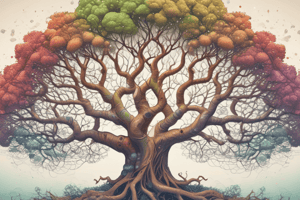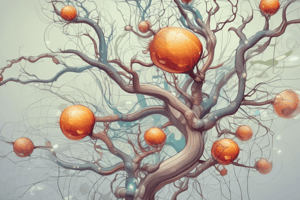Podcast
Questions and Answers
What is the study of interactions between organisms and their environment?
What is the study of interactions between organisms and their environment?
- Microbiology
- Biochemistry
- Ecology (correct)
- Botany
Which organelle is responsible for generating energy for the cell?
Which organelle is responsible for generating energy for the cell?
- Nucleus
- Lysosomes
- Mitochondria (correct)
- Ribosomes
What is the scientific study of heredity and variation?
What is the scientific study of heredity and variation?
- Microbiology
- Ecology
- Genetics (correct)
- Botany
What is the process by which organisms adapt to their environment?
What is the process by which organisms adapt to their environment?
What is the term for the variety of species, ecosystems, and genes?
What is the term for the variety of species, ecosystems, and genes?
What is the scientific study of the structure, function, and evolution of cells?
What is the scientific study of the structure, function, and evolution of cells?
What is the process by which genetic information is passed from one generation to the next?
What is the process by which genetic information is passed from one generation to the next?
What is the study of the chemical processes within living organisms?
What is the study of the chemical processes within living organisms?
Flashcards are hidden until you start studying
Study Notes
Branches of Biology
- Botany: study of plants
- Zoology: study of animals
- Microbiology: study of microorganisms
- Ecology: study of interactions between organisms and their environment
- Biochemistry: study of chemical processes within living organisms
- Molecular Biology: study of biological molecules and their interactions
- Genetics: study of heredity and variation
- Evolutionary Biology: study of evolution and its mechanisms
Cell Biology
- Cell Structure:
- Plasma membrane
- Cytoplasm
- Nucleus
- Mitochondria
- Ribosomes
- Cell Functions:
- Metabolism
- Growth and Development
- Response to Stimuli
- Reproduction
Genetics
- Mendelian Genetics:
- Laws of Inheritance
- Segregation
- Independent Assortment
- DNA Structure:
- Double Helix Model
- Nucleotides (A, C, G, T)
- Base Pairing
- Gene Expression:
- Transcription
- Translation
- Regulation of Gene Expression
Evolution
- Mechanisms of Evolution:
- Natural Selection
- Genetic Drift
- Mutation
- Gene Flow
- Evidence for Evolution:
- Fossil Record
- Comparative Anatomy
- Molecular Biology
- Types of Evolution:
- Microevolution
- Macroevolution
Ecology
- Levels of Organization:
- Individual
- Population
- Community
- Ecosystem
- Biosphere
- Ecosystem Components:
- Biotic Factors (living)
- Abiotic Factors (non-living)
- Energy Flow:
- Producers (autotrophs)
- Consumers (heterotrophs)
- Decomposers
Other Key Concepts
- Homeostasis: maintaining a stable internal environment
- Adaptation: trait that enhances survival and reproduction
- Symbiosis: close relationship between different species
- Biodiversity: variety of species, ecosystems, and genes
Branches of Biology
- Botany focuses on the study of plants, including their structure, properties, and biochemical processes.
- Zoology is dedicated to the study of animals, exploring their behavior, physiology, and classification.
- Microbiology examines microorganisms, including bacteria, viruses, fungi, and protozoa, and their interactions with larger organisms.
- Ecology investigates the relationships between organisms and their environment, including ecosystem dynamics.
- Biochemistry studies the chemical processes and substances that occur within living organisms, essential for understanding life at a molecular level.
- Molecular Biology explores the structure and function of biological macromolecules such as DNA, RNA, and proteins, and their roles in cellular processes.
- Genetics covers heredity and variation in organisms, focusing on the transmission of genes and traits from one generation to the next.
- Evolutionary Biology examines the processes and patterns of biological evolution, providing insights into the history and development of life on Earth.
Cell Biology
- Cell structure consists of key components like the plasma membrane (boundary of the cell), cytoplasm (aqueous environment), nucleus (control center with genetic material), mitochondria (powerhouse generating energy), and ribosomes (sites of protein synthesis).
- Cell functions encompass metabolism (chemical reactions for energy and growth), growth and development (cellular processes leading to organismal growth), response to stimuli (how cells react to environmental changes), and reproduction (cell division and gamete formation).
Genetics
- Mendelian Genetics outlines principles of inheritance, including the laws of segregation (alleles segregate during gamete formation) and independent assortment (genes for different traits segregate independently).
- DNA structure is characterized by the double helix model, which comprises nucleotides (adenine, cytosine, guanine, and thymine) and specific base pairing (A with T, C with G).
- Gene expression involves transcription (creating RNA from DNA), translation (synthesizing proteins from RNA), and the regulation of gene expression, determining when and how genes are activated.
Evolution
- Mechanisms of evolution include natural selection (survival of the fittest), genetic drift (random changes in allele frequencies), mutation (spontaneous changes in DNA), and gene flow (movement of genes between populations).
- Evidence for evolution is demonstrated through the fossil record (historical evidence of organisms), comparative anatomy (similarities in structure across species), and molecular biology (genetic similarities among organisms).
- Types of evolution encompass microevolution (small-scale changes within a species) and macroevolution (large-scale changes that can lead to new species).
Ecology
- Levels of organization in ecology range from the individual (single organism) to the population (group of individuals of the same species), community (interacting populations), ecosystem (community plus abiotic factors), and biosphere (global ecological system).
- Ecosystem components include biotic factors (living organisms) and abiotic factors (non-living elements such as climate and soil).
- Energy flow in ecosystems involves producers (autotrophs converting sunlight into energy), consumers (heterotrophs obtaining energy from other organisms), and decomposers (organisms that break down dead material, recycling nutrients).
Other Key Concepts
- Homeostasis refers to the ability of an organism to maintain a stable internal environment despite external changes, essential for survival.
- Adaptation is a trait or feature that enhances an organism's ability to survive and reproduce in its environment.
- Symbiosis denotes a close, often long-term interaction between different species, which can be beneficial, neutral, or harmful.
- Biodiversity highlights the variety of life forms, ecosystems, and genetic differences within a given habitat, playing a crucial role in ecological balance and resilience.
Studying That Suits You
Use AI to generate personalized quizzes and flashcards to suit your learning preferences.




